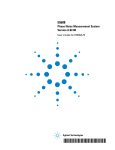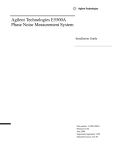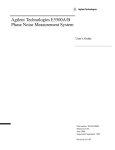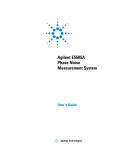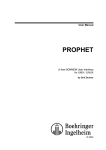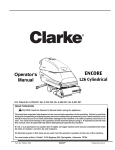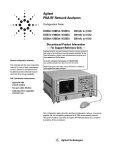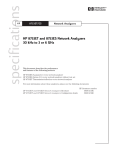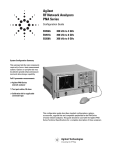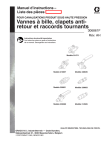Download Agilent Technologies E5500 Series Specifications
Transcript
Agilent PN E5500-1 Pulsed Carrier Phase Noise Measurements Using Agilent E5500 Series Solutions Product Note Table of Contents 3 1. Introduction 4 2. Making residual (two-port) measurements on pulsed carriers Residual measurement considerations Hardware configuration Step-by-step procedure Example 1: Residual noise floor using an Agilent 83732B as the source (non-pulsed carrier) Example 2: Pulsed carrier noise floor using an Agilent 83732B as the stimulus source Example 3: Residual measurement of an Agilent 8347A amplifier 22 3. Making absolute phase noise measurements on pulsed carriers Absolute phase noise measurement considerations Hardware configuration Step-by-step procedure Example 1: Absolute pulsed measurement— Agilent 8663A versus Agilent 83732B Using a microwave downconverter Example 2: Absolute pulsed measurement using a microwave downconverter—Agilent 8644B versus Agilent 83732B 32 4. Making AM noise measurements on pulsed carriers Measurement considerations PRF filtering Measurement calibration Example 1: Agilent 83732B pulsed AM noise measurement using the internal AM detector 1. Introduction The sensitivity and usefulness of many wireless RF and microwave systems is limited by the phase noise characteristics of their system. In pulsed radar systems, for example, the phase noise of the receiver local oscillator sets the minimum signal level that must be returned from a target for it to be detected. In this case, phase noise affects the selectivity of the radar receiver, which in turn determines the effective range of the overall system. Since the overall dynamic range of the radar system is influenced by the noise of the transmitted signal, it is important to know not only the absolute noise of individual oscillators but also the residual or additive noise of the signal processing devices, such as power amplifiers and pulse modulators. In addition, because the final signal in most radar systems is pulsed, making absolute phase noise measurements on the pulsed carrier is essential to determining the overall performance of the system. This product note discusses the use and limitations of the Agilent Technologies E5500 series phase noise measurement solutions for making pulsed carrier phase noise measurements. It is assumed that the reader is familiar with the concepts of phase noise and CW phase noise measurement techniques and with the general application considerations for measuring pulsed carrier signals. For a more detailed discussion of these topics, refer to Agilent Application Note 1309, Pulsed Carrier Phase Noise Measurements (literature number 5968-2081E). Chapter 2 presents the recommended hardware configurations and step-by-step measurement procedure for making residual (two-port) measurements on pulsed RF carriers. Chapter 3 covers the recommended hardware configurations and step-by-step measurement procedures for making absolute measurements on pulsed carriers. Chapter 4 is a brief discussion of AM noise measurements with the Agilent E5500 series. 3 2. Making residual (two-port) measurements on pulsed carriers This chapter presents the recommended procedures and hardware configurations for making residual or two-port phase noise measurements on pulsed carriers. Residual measurement considerations Phase detector selection For carrier frequencies greater than the standard input frequency range, another phase detector must be used. This detector may be either an external phase detector (whose output would be routed to the noise input port of the Agilent 70420A phase noise test set) or an optional internal microwave phase detector: Standard (internal) Option 201 (internal) Option 001 (internal) 50 kHz–1.6 GHz 1.2 GHz–26.5 GHz 1.2 GHz–26.5 GHz Path delay differences When making pulsed carrier residual phase noise measurements, the delay differences between the two paths will normally not be a concern. If the PRF (Pulse Repetition Frequency) is high, and comparisons are being made to non-pulsed or CW measurements, then the time delay difference in the two paths between the power splitter and the phase detector should be kept to a minimum. The attenuation of the stimulus source’s noise is a function of offset frequency (f) and the difference in delay time (∆τ): stimulus source noise attenuation (dB) = 20 log (2 sin (πf ∆τ)). At f = 1/(2π ∆τ) the attenuation goes to 0 dB and at 1/(2 ∆τ), there is a 6 dB gain. 4 Measurement noise floor The measurement noise floor represents the lowest level of noise the system is capable of measuring. For CW signals, it is set by the noise floor of the phase detector, the LNA (Low-Noise Amplifier), and the AM noise feedthrough. Additionally, for pulsed carrier signals, the duty cycle of the pulsed signal further degrades the CW noise floor by a 20*log (duty cycle) factor due to a scaling of the effective detector constant by the duty cycle. The noise of the phase detector is a function of the signal power present at the detector input ports. The recommended power levels (CW or peak) for the microwave phase detector, to ensure maximum sensitivity (lowest noise floor), minimum DC offset and minimum AM noise feedthrough, are +7 to +10 dBm for the reference input port and 0 to +5 dBm for the signal input port. The recommended power levels (CW or peak) for the RF phase detector are +15 dBm for the reference port input and +10 dBm for the signal input port. Source AM noise The stimulus source used for residual measurements must have low AM noise characteristics. AM noise can cause AM-to-PM conversion within the DUT (Device Under Test) and it can degrade the overall measurement system noise floor. Source AM noise suppression For absolute phase noise measurements, AM noise contributions to the baseband signal (after the phase detector) are typically well below the phase noise contributions and therefore are usually ignored. For a residual phase noise measurement, however, the contribution to the baseband signal from AM noise can often exceed the contribution of the system phase noise contribution (measurement system phase noise floor). The largest contributor to AM noise present at the input ports of the phase detector is the stimulus source used for the residual measurement. The typical suppression of AM noise is 20 to 30 dB for an RF phase detector and 10 to 20 dB for a microwave phase detector. As shown in Figure 2-1, the AM noise of a stimulus source can significantly influence the measurable noise floor of a residual phase noise measurement. Measurement offset range The offset range for the measurement is limited to PRF/2, based on sampling theory. Phase transients Since the DUT is pulsed, phase transients may appear at the output of the phase detector. If these phase transients are large enough, the test set LNA gain may be reduced, degrading the overall measurement noise floor. In the 70420A phase noise test set, LNA overload is monitored by a DC-coupled peak detector on the output of the LNA. The overload setpoint, which has been established for CW operation, is set at ±2.5 Vpk at the output of the LNA or ±0.5 Vpk at the monitor port. As shown in Figure 2-2, the amplitude of the leading or trailing phase transient may exceed the CW trip point, but only for a fraction of the pulse width. Even though the LNA is not experiencing an overload condition across the entire pulse width, the system—having sensed an overload condition— will remove LNA gain from the measurement path. To overcome this situation, it is acceptable to override the hardware overload detector. Figure 2-1. AM noise floor versus Phase noise floor 5 The operator can place the LNA in a “fixed” gain configuration and select the amount of gain to use (14 dB to 56 dB of gain in 14-dB steps), or the operator can select “pause after auto LNA gain” and manually adjust the LNA gain before the measurement is started. It is also acceptable to manually select an internal low-pass filter (LPF) to help reduce the phase transients—being coincident with the pulse, they will appear as PRF feedthrough (which usually necessitates the use of a PRF filter). When monitoring the phase transients of the baseband signal (with a wide-band oscilloscope connected to the monitor port of the 70420A), the signal at the monitor port is 14 dB (5 times) lower than the baseband signal. needed, overall system noise floor can be degraded. The 70420A phase noise test set provides a group of internal low-pass filters that can reduce the magnitude of the PRF feedthrough signals. When measuring pulsed carriers, it is recommended that the operator place the test set LNA low-pass filters in manual and select the filter that provides just enough offset range for the pulsed measurement (PRF/2). Refer to Table 2-1 for the proper selection of the LNA low-pass filter. If these internal lowpass filters are not sufficient for a particular PRF, an external phase detector with external low-pass filtering will be required. PRF feedthrough If the PRF feedthrough overloads the LNA for more than 10 percent of the pulse width, measurement accuracy can be degraded. If the magnitude of the PRF feedthrough causes the LNA to be set to a lower-than-appropriate gain or the baseband signal analyzer to be set to a less sensitive range than PRF LNA Low-Pass Filter ≤40 kHz >40 kHz to ≤400 kHz >400 kHz to ≤4 MHz >4 MHz to ≤40 MHz 20 kHz 200 kHz 2 MHz 20 MHz Table 2-1. Selecting an Internal Low-Pass Filter Figure 2-2. Phase transients (100 MHz LPF & max LNA gain) as observed on a scope connected to the monitor port of the Agilent 70420 6 Minimum duty cycle The duty cycle of the pulsed carrier has a direct impact on the system noise floor. This is seen as a scaled degradation of the noise floor by 20 log (duty cycle) in a residual measurement, due to a scaling of detector constant by the duty cycle. While the recommended minimum duty cycle of 1 percent was selected to provide a usable noise floor, it is possible to reduce the duty cycle even further, providing the system noise floor remains low enough to be useful for the measurement. Table 2-2. Noise Floor Degradation with Duty Cycle Figure 2-3. Baseband pulse transients (max. LNA gain and 20 MHz LPF) Figure 2-4. Baseband pulse transients (max. LNA gain and 2 MHz LPF) Duty Cycle Noise Floor Degradation 50% 10% 1% 6 dB 20 dB 40 dB 7 As shown with Figures 2-5 and 2-6, the recommended calibration method is “Derive From SingleSided Band Spur” to measure the phase detector constant automatically (this technique is described in the Agilent E5500 series user documentation). The double-sided spur technique may also be used. The spur frequency must be kept below PRF/4. These techniques allow the phase detector constant to be measured with the DUT configured into the measurement. Hardware configuration The recommended method for making pulsed residual measurements is to synchronously pulse both paths to the phase detector. Using this approach, the phase detector produces an output during the pulse “ON” interval. This eliminates several problems that occur when only the DUT path is pulsed. Figure 2-5 shows the recommended hardware configuration with one external pulse modulator. Figure 2-6 shows the recommended configuration with two external pulse modulators. Both configurations assume that the source cannot be pulsed, or that the AM noise of the source, when pulsed internally, increases significantly from its CW (non-pulsed) value, reducing the overall measurement noise floor to an unusable level. A wide-band oscilloscope connected to the monitor port of the 70420A is recommended as the quadrature set and monitor device to see the phase transients that may be produced as a result of the pulse modulation process. DUT Step Attenuator Source Pulse Modulator Amplifier E5500 Input Splitter Phase Shifter Pulse Gen 16 dB Coupler Ref Input Cal Source Figure 2-5. Residual pulsed carrier measurement configuration Pulse Modulator Source Amplifier DUT Step Attenuator Input Splitter Pulse Modulator Pulse Gen E5500 Phase Shifter 16 dB Coupler Ref Input Cal Source Figure 2-6. Residual pulsed carrier measurement configuration (alternate) 8 Step-by-step procedure The following step-by-step procedure can be used when making pulsed residual measurements with any Agilent E5500 series phase noise measurement solution. Modifications will be required for different carrier frequencies, duty cycles, PRF, source types, and so forth. Three measurement examples using the same basic procedure are given: 1) a noise floor measurement for a non-pulsed carrier signal; 2) a noise floor measurement for a pulsed carrier signal; and 3) a DUT measurement. Example 1: Residual noise floor using an Agilent 83732B as the source (non-pulsed carrier) While this measurement uses a non-pulsed carrier signal, the actual measurement configuration will be the same as the configuration for a pulsed carrier signal. The resulting noise floor measurement will then incorporate all of the components used in the pulsed carrier situation. It is possible to predict the pulsed carrier noise floor from the non-pulsed carrier noise floor if the duty cycle of the pulsed signal is known. Attenuator 83732B Stimulus Source Pulse Modulator Amplifier 2. Set up the stimulus source. a) Carrier frequency: 1.5 GHz b) Amplitude: Set power levels at the connections to the 70420A detector input ports: Ref Input: 7 to 10 dBm Signal Input: 0 to 5 dBm 3. Set up the pulse generator and pulse modulator. a) Duty Cycle = CW (100%) b) PRF = None c) Amplitude = TTL Output 4. Set up the calibration source. a) Carrier frequency: 1.500005000 GHz b) Amplitude: Set spur power level at the 70420A reference input port to –40 dBc @ 5 kHz from CW carrier c) Disconnect calibration signal from coupler E5500 Input Splitter Phase Shifter Pulse Gen 1. Connect the components as shown in Figure 2-7. The amplifier after the pulse modulator may be necessary to set the appropriate power levels at the signal and reference inputs of the phase noise measurement system. Do not connect the signal paths to the phase noise measurement system at this step. 16 dB Coupler Ref Input 8663A Calibration Source Figure 2-7. Connection diagram for residual noise floor measurement 9 5. Set up the phase noise measurement system. a) From the Define menu, choose Measurement; then define the measurement per the parameter data provided in Table 2-3. When all of the forms have been defined, choose the Close button. 6. Select View Meter (Tool Bar Icon). a) This internal meter provides quadrature status; the black bar is not present when quadrature is set. 7. Start New Measurement. a) Select New Measurement from the Measure pulldown menu. 10 b) When the connect diagram is displayed, check hardware and connections. 1) Connect scope to monitor port of 70420A test set. 2) Set scope to monitor waveform. 3) Connect the signal paths to the phase noise test set. 4) Set quadrature (set the signal to zero volts on scope and a null on View Meter). c) Select Continue. d) When prompted by the software, connect the calibration signal from the calibration source to the coupler, then select Continue. e) When prompted by the software, disconnect the calibration signal from the calibration source, then select Continue. 9. Interpret the results. A typical residual noise floor measurement when using the microwave phase detector is shown in Figure 2-8. The noise level close to carrier is influenced by the AM noise characteristics of the stimulus source (in this case, the Agilent 83732B). The rise in the noise level far from carrier (>40 MHz offset) is due to the delay difference in the signal paths. Since this configuration is intended for pulsed carrier measurements, where data is valid only to a PRF/2 offset frequency, this delay difference is acceptable. 8. When the measurement is complete, print the results and save the measurement file. Figure 2-8. CW residual noise floor using an Agilent 83732B as the stimulus source 11 Table 2-3. Parameter Data for CW Residual Noise Floor Measurement Step Parameters Data 1 Type and Range Tab Measurement Type Couple Graph Type Start Offset Frequency Stop Offset Frequency FFT Minimum Number of Averages FFT Quality Swept Quality Residual Phase Noise (without using a phase-lock loop) Checked 10 Hz 100 E+6 Hz 4 Normal Fast Sources Tab Carrier Source Frequency Power Detector Input 1.5E+9 Hz 10 1.5E+9 Hz 2 3 4 5 6 12 Cal Tab Phase Detector Constant Derive From Single-Sided Spur Known Spur Parameters Amplitude Offset Frequency Block Diagram Tab Source Phase Shifter DUT In Path Establish Quadrature By Adjusting Phase Shifter Phase Detector Test Set Tab Input Attenuation (Option 001 only) LNA Low-Pass Filter Auto DC Block LNA Gain Auto Gain Ignore Out-of-Lock Conditions Pulsed Carrier PLL Integration Attenuation Graph Tab Title Graph Type X Scale Minimum Maximum Y Scale Maximum Minimum Normalize Trace Data Scale Trace Data Shift Trace Data Trace Smoothing Amount Power Present At Input of DUT Checked –40 dBc 5E+3 Hz Manual Manual Manual Checked Test Set Microwave Phase Detector Set to provide the appropriate power level at the phase detector Checked Not Checked Checked Not Checked Not Checked 0 dB Residual Noise Floor Measurement Single-Sideband Phase Noise (dBc/Hz) 10 100 E+6 0 –190 1 1 0 0 0 Example 2: Pulsed carrier noise floor using an Agilent 83732B as the stimulus source 1. Connect the components as shown in Figure 2-9. The amplifier after the pulse modulator may be necessary to set the appropriate power levels at the signal and reference inputs of the phase noise measurement system. Do not connect the signal paths to the phase noise measurement system at this step. 4. Set up calibration source. a) Carrier frequency: 1.500005000 GHz (5 kHz offset from the stimulus source) b) Amplitude: Set spur power level at the 70420A reference input port –40 dBc @ 5 kHz from CW carrier c) Disconnect calibration signal from coupler 2. Set up stimulus source. a) Carrier frequency: 1.5 GHz b) Amplitude: Set power levels at the connectors to the 70420A detector input ports: Ref Input: 10 dBm Signal Input: 0 dBm 3. Set up pulse generator. a) Duty Cycle = 10% b) PRF = 20 kHz c) Connect pulse generator output to the pulse modulator. Attenuator 83732B Stimulus Source Pulse Modulator Amplifier Input Splitter Phase Shifter Pulse Gen E5500 16 dB Coupler Ref Input 8663A Calibration Source Figure 2-9. Connection diagram for pulsed carrier residual phase noise measurement 13 5. Set up the phase noise measurement system. a) From the Define menu, choose Measurement; then define the measurement per the parameter data provided in Table 2-4. When all of the forms have been defined, choose the Close button. 6. Select View Meter (Tool Bar icon). a) This internal meter provides quadrature status; the black bar is not present when quadrature is set. 7. Start New Measurement. a) Select New Measurement from the Measure pulldown menu. 14 b) When the connect diagram is displayed, check hardware and connections. 1) Connect scope to monitor port of 70420A test set. 2) Set scope to monitor waveform. 3) Connect the signal paths to the phase noise test set. 4) Set quadrature (set the signal to zero volts on scope and a null on View Meter). c) Select Continue. d) When prompted by the software, connect the calibration signal from the calibration source to the coupler, then select Continue. e) When prompted by the software, disconnect the calibration signal from the calibration source, then select Continue. 8. When the measurement is complete, print the results and save the measurement file. Figure 2-10. Pulsed carrier residual noise floor measurements with 20 kHz LPF 9. Interpret the results. Look for PRF feedthrough, aliasing effects, and any breaks in the graph. If PRF feedthrough is high and there are breaks in the graph, set the LNA Gain to 56 dB of Gain. Start a Repeat measurement and adjust the quadrature at the connect diagram. Note that the pulsed carrier noise floor is not 20 dB greater than the CW noise floor at all offset frequencies. This is due to the AM noise feedthrough of the stimulus source to the output of the microwave phase detector. This AM noise feedthrough is not affected by the pulsed carrier. 15 Figures 2-11 and 2-12 show pulsed residual phase noise measurements where the PRF is 20 kHz and the duty cycle is 10 percent, but different low-pass filters are used to demonstrate the effects of the PRF—even though measurement results are valid only out to PRF/2 in offset frequency. Figure 2-11 shows a broad offset range pulsed carrier measurement using only the default 100-MHz low-pass filter and allowing the system to autorange the LNA. Note the 20 kHz PRF spurious signal and integer multiples of the PRF. The break in the graph at 10 MHz is due to the fact that the PRF lines are too close together to be resolved by the spectrum analyzer (the resolution bandwidth and video bandwidth of the spectrum analyzer can be adjusted to resolve these spurs). There is also a break in the curve at a 1 kHz offset. This is caused by the LNA gain being automatically set to a lower gain than required. (The presence of large phase transients or large PRF lines causes the autoranging of the LNA to select a gain lower than the maximum available.) Figure 2-12 shows a pulsed carrier noise floor measurement using the internal 200 kHz low-pass filter. The low-pass filter reduces the transients within the baseband signal to a level that allows the proper autoranging of the LNA (to select the maximum available gain). The measured results to PRF/2 of offset frequency are virtually identical to the measurement using the 20 kHz LPF. Figure 2-11. Pulsed carrier measurement using 100 MHz LPF Figure 2-12. Pulsed carrier measurement using 200 kHz LPF 16 Table 2-4. Parameter Data for Pulsed Carrier Residual Noise Floor Measurement Step Parameters Data 1 Type and Range Tab Measurement Type Couple Graph Type Start Offset Frequency Stop Offset Frequency FFT Minimum Number of Averages FFT Quality Swept Quality Residual Phase Noise (without using a phase-lock loop) Checked 10 Hz 20 E+3 Hz 4 Normal Fast Sources Tab Carrier Source Frequency Power Detector Input 1.5E+9 Hz 10 1.5E+9 Hz 2 3 4 5 6 Cal Tab Phase Detector Constant Derive From Single-Sided Spur Known Spur Parameters Amplitude Offset Frequency Block Diagram Tab Source Phase Shifter DUT In Path Establish Quadrature By Adjusting Phase Shifter Phase Detector Test Set Tab Input Attenuation (Option 001 only) LNA Low-Pass Filter Auto DC Block LNA Gain Pause after Auto Gain Adjustment Ignore Out-of-Lock Conditions Pulsed Carrier PLL Integration Attenuation Graph Tab Title Graph Type X Scale Minimum Maximum Y Scale Maximum Minimum Normalize Trace Data Scale Trace Data Shift Trace Data Trace Smoothing Amount Power Present At Input of DUT Checked –40 dBc 5E+3 Hz Manual Manual Manual Checked Test Set Microwave Phase Detector Set to provide the appropriate power level at the phase detector 20 kHz Not Checked Not Checked Checked Not Checked Checked 0 dB Pulsed 10% DC 20 kHz PRF Residual Single-Sideband Phase Noise (dBc/Hz) 10 100 E+6 0 –190 1 1 0 0 0 17 Example 3: Residual measurement of an Agilent 8347A amplifier In this configuration, the phase detector constant will be measured with the DUT configured into the measurement. If the power levels into the Agilent 70420A are the same as in Example 2, the phase detector constant will also be similar. 1. Connect the components as shown in Figure 2-13. The amplifier after the pulse modulator may be necessary to set the appropriate power levels at the signal and reference inputs of the phase noise measurement system. The attenuator prior to the amplifier-under-test may be necessary to adjust the power level at the input to the phase noise test set and keep the amplifier out of compression. Do not connect the signal paths to the phase noise measurement system at this step. 2. Set up stimulus source. a) Carrier frequency: 1.5 GHz b) Amplitude: Set power levels at the connectors to the 70420A detector input ports: Ref Input: 10 dBm Signal Input: 0 dBm Attenuator 83732B Stimulus Source 3. Set up pulse generator. a) Duty Cycle = 10% b) PRF = 20 kHz c) Connect pulse generator output to the pulse modulator. 4. Set power in to DUT (8347A). a) Measure the power at the input to the DUT with the RF spectrum analyzer. b) Attenuate the signal to place the amplifier in its linear range. c) Set the ALC selection for the amplifier to “OFF.” d) Measure the power output of the DUT. e) Attenuate the signal to set the power level to approximately 0 to +5 dBm at the input to the phase detector. 5. Set up calibration source. a) Carrier frequency: 1.500005000 GHz b) Amplitude: Set spur power level at the 70420A reference input port –40 dBc @ 5 kHz from CW carrier. c) Disconnect calibration signal from coupler. E5500 DUT Pulse Modulator Amplifier Input Splitter 8437A Phase Shifter Pulse Gen 16 dB Coupler Ref Input 8663A Calibration Source Figure 2-13. Configuration diagram for amplifier pulsed carrier residual phase noise measurement 18 6. Set up the phase noise measurement system. a) From the Define menu, choose Measurement; then define the measurement per the parameter data provided in Table 2-5. When all of the forms have been defined, click the Close button. 7. Select View Meter (Tool Bar icon). a) This internal meter provides quadrature status; the black bar is not present when quadrature is set. 8. Start New Measurement. a) Select New Measurement from the Measure pulldown menu. 19 b) When the connect diagram is displayed, check hardware and connections. 1) Connect scope to monitor port of 70420A test set. 2) Set scope to monitor waveform. 3) Connect the signal paths to the phase noise test set. 4) Set quadrature (set the signal to zero volts on scope and a null on View Meter). c) Select Continue. d) When prompted by the software, connect the calibration signal from the calibration source to the coupler, then select Continue. e) When prompted by the software, disconnect the calibration signal from the calibration source, then select Continue. 8. When the measurement is complete, print the results and save the measurement file. Figure 2-14. Pulsed carrier amplifier residual measurement with 200-kHz LPF 9. Interpret the results. Note the PRF feedthrough, aliasing effects, and any breaks in the graph. If PRF feedthrough is high and there are breaks in the graph, set the LNA Gain to 56 dB of gain and watch for clipping on the monitor oscilloscope. Start a Repeat measurement and adjust the quadrature at the connect diagram. 20 Table 2-5. Parameter Data for Pulsed Carrier Amplifier Residual Measurement Step Parameters 1 Type and Range Tab Measurement Type Couple Graph Type Start Offset Frequency Stop Offset Frequency FFT Minimum Number of Averages FFT Quality Swept Quality Residual Phase Noise (without using a phase-lock loop) Checked 10 Hz 200 E+3 Hz 4 Normal Fast Sources Tab Carrier Source Frequency Power Detector Input 1.5E+9 Hz 10 1.5E+9 Hz 2 3 4 5 6 Cal Tab Phase Detector Constant Derive From Single-Sided Spur Known Spur Parameters Amplitude Offset Frequency Block Diagram Tab Source Phase Shifter DUT In Path Establish Quadrature By Adjusting Phase Shifter Phase Detector Test Set Tab Input Attenuation (Option 001 only) LNA Low-Pass Filter Auto DC Block LNA Gain Pause after Auto Gain Adjustment Ignore Out-of-Lock Conditions Pulsed Carrier PLL Integration Attenuation Graph Tab Title Graph Type X Scale Minimum Maximum Y Scale Maximum Minimum Normalize Trace Data Scale Trace Data Shift Trace Data Trace Smoothing Amount Power Present At Input of DUT Data Checked –40 dBc 5E+3 Hz Manual Manual Manual Checked Test Set Microwave Phase Detector Set to provide the appropriate power level at the phase detector 200 kHz Not Checked Not Checked Checked Not Checked Checked 0 dB 8347A (ALC Off) 20 kHz PRF 10% DC 200 kHz LPF Single-Sideband Phase Noise (dBc/Hz) 10 100 E+6 0 –190 1 1 0 0 0 21 3. Making absolute phase noise measurements on pulsed carriers This chapter presents the recommended procedures and hardware configurations for making absolute phase noise measurements on pulsed carriers. For a complete description of how pulsing the carrier affects phase noise measurements, refer to Agilent Application Note 1309 Pulsed Carrier Phase Noise Measurements (literature number 5968-2081E). Absolute phase noise measurement considerations Measurement noise floor The measurement noise floor represents the lowest level of noise the system is capable of measuring. For CW signals, it is set by the noise of the test set (phase detector and LNA), the noise of the comparison reference oscillator, the noise of the microwave downconverter, or a combination of all three—provided sufficient power is available at the phase detector input ports. Additionally, for pulsed carrier signals, the duty cycle of the pulsed signal further degrades the CW test set noise floor by a 20*log (duty cycle) factor. The recommended power levels for the microwave phase detector are +7 to +10 dBm for the reference input port and 0 to +5 dBm for the signal input port. The recommended power levels (CW or peak) for the RF phase detector are +15 to +23 dBm for the reference input port and 0 to +15 dBm for the signal input port. Measurement offset range The offset range for the measurement is limited to PRF/2, based on sampling theory. 22 PRF feedthrough If the magnitude of the PRF feedthrough overloads the phase noise test set LNA for more than 10 percent of the pulse width, measurement accuracy may be degraded. If the magnitude of the PRF feedthrough causes the LNA to be set to a lower than appropriate gain or the baseband signal analyzer to be set to a less sensitive range than needed, overall system noise floor can be degraded. The 70420A phase noise test set provides a group of internal low-pass filters that can reduce the magnitude of the PRF feedthrough signals. When measuring pulsed carriers, it is recommended that the operator place the test set LNA low-pass filters in manual and select the filter that provides just enough offset range for the pulsed measurement (PRF/2). Refer to Table 3-1 for the proper selection of the LNA low-pass filter. If these internal lowpass filters are not sufficient for a particular PRF, an external phase detector with external low-pass filtering will be required. Table 3-1. Selecting an Internal Low-Pass Filter PRF LNA Low-Pass Filter ≤40 kHz >40 kHz to ≤400 kHz >400 kHz to ≤4 MHz >4 MHz to ≤40 MHz 20 kHz 200 kHz 2 MHz 20 MHz Minimum duty cycle The duty cycle of the pulsed carrier has a direct impact on the system noise floor. This is seen as a scaled degradation of the noise floor by 20 log (duty cycle) in a residual measurement. The recommended minimum duty cycle of 5 percent was selected to provide a usable PLL signal that is necessary to phase-lock the reference source see Table 3-2. It is possible to reduce the duty cycle to less than 5 percent, providing there is sufficient signal for the PLL circuitry to achieve phase-lock. Table 3-2. Noise Floor Degradation with Duty Cycle Duty Cycle Test Set Noise Floor Degradation 50% 10% 5% 6 dB 20 dB 26 dB Peak tuning range The peak tuning range (PTR) must be <PRF/2; otherwise, when the phase detector constant is measured, the beat note will be confused with the PRF lines. This also guarantees that the PLL bandwidth will be less than the frequency of the PRF, which is necessary for stability. If the PLL bandwidth approaches PRF/2, excessive phase shift (due to the sampling process that the pulsing effectively represents) will cause the loop to peak or become unstable. VCO tune constant The VCO tuning sensitivity cannot be measured under pulsed conditions because the system cannot differentiate between a beat note and a PRF line. Consequently, the VCO tune constant must be entered manually. It can be determined from a CW measurement and entered for the pulsed measurement, or it can be known or calculated (as in the case of a signal generator) and entered into the software. Zero-beat of sources Under pulsed carrier conditions, the system cannot zero-beat the reference source automatically, because it cannot differentiate between a beat note and a PRF line. The operator must manually zero-beat the two sources to within 5 percent of the PTR. Ignore-out-of-lock For pulsed carrier measurements, the ignoreout-of-lock condition must be selected because of the PRF feedthrough. The out-of-lock circuitry will detect the PRF lines and interpret them as beat notes. The presence of a beat note normally indicates that the loop is not phase-locked. When ignore-out-of-lock is selected, the operator is responsible for ensuring that phase-lock is established and maintained during the measurement. This is accomplished by connecting a wide-band oscilloscope to the monitor port of the 70420A test set to verify the absence of a beat note and to monitor the DC output level during the measurement. 23 Example 1: Absolute pulsed measurement— Agilent 8663A versus 83732B 1. Connect the components as shown in Figure 3-1, with the exception of routing the pulse generator signal directly to the “External Pulse Input” port of the Agilent 83732B. The 83732B is internally pulse modulated instead of externally. Do not connect the signal paths to the phase noise measurement system at this step. Hardware configuration The recommended hardware configuration for making pulsed absolute measurements will provide a synchronized pulsed carrier signal to both ports of the phase detector. Using this approach, the phase detector produces an output during the pulse “ON” interval. Figure 3-1 shows the recommended configuration when a source cannot be internally pulsed (connecting a pulse modulator to the output of a source). 2. Set up the DUT (83732B). a) Carrier frequency: 1.5 GHz b) Amplitude: Set source power level for +10 dBm at input port of 70420A. c) External Pulse Enable Step-by-step procedure The following step-by-step procedure can be used when making pulsed absolute measurements with the Agilent E5500 series phase noise measurement solutions. Modifications will be required for different carrier frequencies, duty cycles, PRFs, source types, and so forth. Two measurement examples will be given: 1) a pulsed carrier absolute measurement; and 2) a pulsed carrier absolute measurement using a microwave downconverter. 3. Set up the pulse generator. a) Duty Cycle = 10% b) PRF = 20 kHz c) Amplitude = TTL output 83732B Source "DUT" Pulse Modulator Input External Pulse Input Pulse Generator EFC Input PLL Pulse 8663 A Modulator Calibration RF Source Output Reference Input Tune Volts Out Figure 3-1. Pulsed carrier absolute phase noise measurement configuration 24 4. Set up 8663A reference source. Since the zero-beat process must be manually instigated, the reference source must be operated in a manual mode only: a) Carrier frequency: 1.5 GHz. b) Amplitude: Set source power level to attain +15 dBm at the reference input port. c) EFC input port (rear panel) connected to the Voltage Tune port of 70420A. 5. Set up the phase noise measurement system. a) From the Define menu, choose Measurement; then define the measurement per the parameter data provided in Table 3-3. When all of the forms have been defined, choose the Close button. 6. Start New Measurement. a) Select New Measurement from the Measure pulldown menu. b) When the connect diagram is displayed, check hardware and connections. 1) Connect scope to monitor port of 70420A test set. 2) Set scope to monitor waveform. 3) Connect the signal paths to the phase noise test set. 4) Verify that a beat note exists within the RF pulse “ON” time. 5) Zero-beat sources to reduce beat note to <5 percent of PTR (7 Hz). (This is often accomplished in a non-pulsed condition since it is very difficult to view the beat note within the RF pulse, as observed on the oscilloscope.) c) Select Continue. 25 If the Out-of-Lock warning message appears, verify that the voltage within the RF pulse “ON” portion is zero volts (observed on the scope). If phase-lock has been achieved, select Continue; if phase-lock has not been achieved, select Re-try. Phase lock indications include a flat zero-volt trace (no presence of any beat note or search signal). 7. When the measurement is complete, print the results and save the measurement file. Figure 3-2. Absolute phase noise measurement for an Agilent 83732B under pulsed carrier conditions 26 Table 3-3. Parameter Data for Pulsed Carrier Absolute Phase Noise Measurement Step Parameters Data 1 Type and Range Tab Measurement Type Couple Graph Type Start Offset Frequency Stop Offset Frequency FFT Minimum Number of Averages FFT Quality Swept Quality Absolute Phase Noise (using a phase-locked loop) Checked 10 Hz 20E+3 4 Normal Fast 2 3 4 5 6 Sources Tab Carrier Source Frequency Carrier Source Power Power Detector Input Frequency Reference Source Power Detector Input Freq = Ref Freq multiplied by Nominal Tune Constant Tune Range Center Voltage Input Resistance 1.5E+9 Hz 7 7 1.5E+9 Hz 16 dBm 1/1 15 Hz/V 10 0 600 ohms Cal Tab Phase Detector Constant VCO Tune Constant Verify calculated phase-locked loop suppression Always Show Suppression Graph Not Checked Not Checked Block Diagram Tab Carrier Source Downconverter Reference Source Phase Detector Test Set Tune Voltage Destination VCO Tune Mode Manual None Selected Manual Test Set RF Phase Detector Reference Source EFC Test Set Tab Input Attenuation (Option 001 only) LNA Low-Pass Filter Auto DC Block LNA Gain Ignore Out-of-Lock Conditions Pulsed Carrier PLL Integration Attenuation Set to provide appropriate power level to phase detector 20 kHz Not Checked Not Checked Auto Gain Selected Checked Checked 0 dB Graph Tab Title Graph Type X Scale Minimum X Scale Maximum Y Scale Maximum Y Scale Minimum Normalize Trace Data Scale Trace Data Shift Trace Data Trace Smoothing Amount Power Present At Input of DUT Pulsed 83732B vs 8663A EFC 20 kHz PRF 10% Duty Cycle Single-Sideband Phase Noise (dBc/Hz) 10 100 E+6 0 –170 1 1 0 0 0 Measure phase detector constant Calculate from expected 27 3. Set up pulse generator. a) Duty Cycle = 10% b) PRF = 20 kHz c) Amplitude = TTL level Using a microwave downconverter For carrier frequencies in the microwave range, the Agilent 70421A, 70422A, and 70427A microwave downconverters are available to downconvert a pulsed carrier to the RF frequency range, making it much easier to perform pulsed absolute phase noise measurements. In this configuration, the microwave downconverter is used to establish a measurement PLL. 4. Set up 8644B reference source. Since the zerobeat process must be manually instigated, the reference source must be operated in a manual mode only: a) Carrier frequency: 300 MHz (if using an 70421A or 70422A downconverter) 900 MHz (if using an 70427A downconverter) b) Amplitude: Set source power level for +15 dBm at the reference input port. Example 2: Absolute pulsed measurement using a microwave downconverter— Agilent 8644B versus 83732B 1. Connect the components as shown in Figure 3-3. Do not connect the signal paths to the phase noise measurement system at this step. 2. Set up DUT (83732B). a) Carrier frequency: 1.5 GHz b) Amplitude: Set source power level to attain >10 dBm at the 70420A signal input port when using an 70420A Opt. 001, or at the downconverter input port if using an 70420A standard or Option 201. c) External Pulse Enable 83732B Tune Volts IN Source Pulse "DUT" Modulator Tune Volts Out Microwave Downconverter PLL Input External Pulse Input Input Pulse Generator 8644B Reference Source Pulse Modulator Reference Input E5500 Figure 3-3. Pulsed carrier absolute phase noise measurements using a microwave downconverter 28 5. Set up the phase noise measurement system. a) From the Define menu, choose Measurement; then define the measurement per the parameter data provided in Table 3-4. When all of the forms have been defined, choose the Close button. b) For this configuration, the 10-MHz reference oscillator within the down converter will be tuned to achieve measurement phase-lock. The internal PLL loops of the downconverter restrict the acceptable closed-loop measurement bandwidth to <<126 Hz. With an openloop PTR of 75 Hz, this narrow closed-loop bandwidth is achieved by selecting 12 dB of PLL integrator attenuation (located on Test Set definition page). 6. Start New Measurement. a) Select New Measurement from the Measure pulldown menu. b) When the connect diagram is displayed, check hardware and connections. 1) Connect scope to monitor port of 70420A test set. 2) Set scope to monitor waveform. 3) Connect the signal paths to the phase noise test set. 4) Verify that a beat note exists within the RF pulse “ON” time. 29 5) Zero-beat sources to reduce beat note to <5 percent of PTR (2 Hz). (This is often accomplished in a non-pulsed condition since it is very difficult to view the beat note within the RF pulse, as observed on the oscilloscope.) c) Select Continue. If the Out-of-Lock warning message appears, verify that the voltage within the RF pulse “ON” portion is zero volts (observed on the scope). If phase-lock has been achieved, select Continue; if phase-lock has not been achieved, select Re-try. Phase-lock indications include a flat zero-volt trace (no presence of any beat note or search signal). 6. When the measurement is complete, print the results and save the measurement file. Figure 3-4. Pulsed carrier PLL phase noise measurement of Agilent 83732B versus 8644B 30 Table 3-4. Parameter Data for Pulsed Carrier Absolute Phase Noise Measurement with a Downconverter Step Parameters Data 1 Type and Range Tab Measurement Type Couple Graph Type Start Offset Frequency Stop Offset Frequency FFT Minimum Number of Averages FFT Quality Swept Quality Absolute Phase Noise (using a phase-locked loop) Checked 10 Hz 20E+3 4 Normal Fast 2 3 4 5 6 7 Sources Tab Carrier Source Frequency Carrier Source Power Power Detector Input Frequency Reference Source Power Detector Input Freq = Ref Freq multiplied by Nominal Tune Constant Tune Range Center Voltage Input Resistance 1.5E+9 Hz 7 7 300 E+6 Hz 16 dBm 1/1 75 Hz/V 1 0 600 ohms Cal Tab Phase Detector Constant VCO Tune Constant Verify calculated phaselocked loop suppression Always Show Suppression Graph Not Checked Not Checked Block Diagram Tab Carrier Source Downconverter Reference Source Phase Detector Test Set Tune Voltage Destination VCO Tune Mode Manual System Control Selected Manual Test Set RF Phase Detector Downconverter DCFM Test Set Tab Input Attenuation (Option 001 only) LNA Low-Pass Filter Auto DC Block LNA Gain Ignore Out-of-Lock Conditions Pulsed Carrier PLL Integration Attenuation Set to provide appropriate power level to phase detector 20 kHz Not Checked Not Checked Auto Gain Selected Checked Checked 12 dB Downconverter Tab Input Frequency LO Frequency IF Gain Input Attenuation Microwave/Millimeter Band LO Power Reference Chain Reference External Tune Enable 100 MHz PLL Bandwidth 600 MHz PLL Bandwidth 1.5 E+9 Auto Selected Auto Selected 0 Microwave (0 – 26.5) 10 dBm 10 MHz Checked 126 Hz 10000 Hz Graph Tab Title Graph Type X Scale Minimum X Scale Maximum Y Scale Maximum Y Scale Minimum Normalize Trace Data Scale Trace Data Shift Trace Data Trace Smoothing Amount Power Present At Input of DUT Pulsed 83732B vs 8663A EFC 20 kHz PRF 10% Duty Cycle Single-Sideband Phase Noise (dBc/Hz) 10 100 E+6 0 –170 1 1 0 0 0 Measure phase detector constant Calculate from expected 4. Making AM noise measurements on pulsed carriers This chapter includes the recommended hardware configurations and step-by-step measurement procedures for making AM noise measurements on pulsed carriers. Measurement considerations Using an external AM detector: 1) Choose a low-barrier Schottky diode detector, if possible, since these detectors will handle more power than a point-contact detector, while being just as sensitive. 2) Terminate the diode with an external AM detector filter (70429A k21). This network prevents the DC voltage component of the demodulated signal from saturating the LNA within the 70420A test set. It also sets the detector DC bias and allows the minimum offset frequency to be 1 Hz. 3) Provide an external PRF filter if the internal 70420A low-pass filters do not provide sufficient PRF filtering for a successful measurement. 4) Provide a coaxial balun (70427A k02) between the detector and the test set to help eliminate ground loop spurious signals and noise. Using an internal AM detector: The 70420A test set with Option 001 provides an internal AM detector to measure AM noise between 10 Hz and 100 MHz of offset range. The test set also provides an internal DC block that limits the minimum offset frequency to 10 Hz. The 70427A microwave downconverter also provides an AM detector that can be used to measure the AM noise of a signal over the offset range of 1 Hz to 100 MHz when an external DC block is used. The output of the AM detector (within the 70427A downconverter) is routed externally to the 70420A’s External Noise Input port. PRF filtering Internal low-pass filters are available to provide PRF filtering for some situations. Because the AM detector produces a high-amplitude replica of the carrier pulse, the PRF filter must have more attenuation than the PRF filter used in the phase noise measurement case. An internal low-pass filter can be used if the cutoff frequency is one-half of the PRF or less. Unless the PRF happens to be one half the cutoff frequency of one of the internal low pass filters, the offset range will be limited by the filter to less than PRF/2. The available internal filters are shown in Table 4-1. 83732B Source "DUT" E5500 Pulse Modulator 16 dB Coupler 33330C 70429A k21 AM Detector Detector Filter 70427A k02 PRF LPF Coax Ref Input Balun Noise Input External Pulse Input Calibration Source Figure 4-1. Pulsed carrier AM noise measurement configuration when using an external AM detector 32 Table 4-1. Selecting an Internal Low-Pass Filter for AM Noise Measurements PRF LNA Low-Pass Filter ≥40 kHz ≥400 kHz ≥4 MHz ≥40 MHz 20 kHz 200 kHz 2 MHz 20 MHz detector is selected. This internal DC block may also be used with an external AM detector, but the minimum offset frequency will be limited to 10 Hz. 1. Connect the components as shown in Figure 4-2. Do not connect the signal path to the phase noise measurement system at this step. However, if the PRF frequency is the same as the low-pass filter, an external PRF filter and AM detector may be required. PRF lines are AM in nature and they will appear at the LNA at full magnitude if PRF filtering does not reduce them sufficiently. Measurement calibration The easiest and most appropriate calibration method for pulsed carrier AM noise measurements is the “Single-Sided Spur Calibration Technique.” This technique is described in the Agilent E5500 series user documentation. The method is the same for pulsed carrier conditions as CW conditions, with the caution that the calibration sidebands must be <PRF/4. Example 1: Agilent 83732B pulsed AM noise measurement using the internal AM detector In this configuration, the internal AM detector of the 70420A Option 001 test set will be used. The optimal input power to the AM detector is +12 to +15 dBm. The test set has an internal DC block that is automatically used when the internal AM 2. Set up the DUT (83732B). a) Carrier frequency: 1.5 GHz. b) Amplitude: Set power level for a +12-dBm signal at the 70420A signal input port. c) External Pulse Enable 3. Set up the pulse generator. a) Duty Cycle = 10% b) PRF = 40 kHz c) Amplitude = required pulse levels for the source 4. Set up the calibration source. a) Carrier frequency: 1.500005000 GHz b) Amplitude: Set the calibration signal power level at the 70420A reference input port to: –40 dBc @ 5 kHz from CW carrier. c) Disconnect calibration signal from coupler. 5. Set up the AM noise measurement system. a) From the Define menu, choose Measurement; then define the measurement per the parameter data provided in Table 4-2 (page 35). When all of the forms have been defined, choose the Close button. 83732B E5500 Source "DUT" Pulse Modulator 16 dB Coupler Input External Pulse Input AM Detector Pulse Modulator Figure 4-2. AM noise measurement configuration using the Agilent 70420A with Option 001 (internal AM detector) 33 6. Start New Measurement. a) Select New Measurement from the Measure pulldown menu. b) At the connect diagram, check hardware and connect the signal path to the signal input of the phase noise test set. c) Select Continue. d) When prompted by the software, connect the calibration signal from the calibration source to the coupler, then select Continue. e) When prompted by the software, disconnect the calibration signal from the calibration source, then select Continue. 7. When the measurement is complete, print the results and save the measurement file. Figure 4-3. AM noise of an Agilent 83732B under pulsed carrier conditions 34 Table 4-2. Parameter Data for Pulsed Carrier AM Noise Measurement with Option 001 Test Set Step Parameters Data 1 Type and Range Tab Measurement Type Couple Graph Type Start Offset Frequency Stop Offset Frequency FFT Minimum Number of Averages FFT Quality Swept Quality AM Noise Checked 10 Hz 20E+3 4 Normal Fast Sources Tab Carrier Source Frequency Carrier Source Power Detector Input Frequency 1.5E+9 Hz 12 1.5E+9 Hz 2 3 4 5 6 Cal Tab Detector Constant Known Spur Parameters Offset Frequency Amplitude 5E+3 –40 Block Diagram Tab Carrier Source Downconverter AM Detector Manual None Selected Test Set AM Detector Test Set Tab Input Attenuation (Option 001 only) LNA Low-Pass Filter Auto DC Block LNA Gain Ignore Out-of-Lock Conditions Pulsed Carrier PLL Integration Attenuation Set to provide appropriate power level to phase detector 20 kHz Not Checked Checked Auto Gain Selected Not Checked Checked 0 dB Graph Tab Title Graph Type X Scale Minimum X Scale Maximum Y Scale Maximum Y Scale Minimum Normalize Trace Data Scale Trace Data Shift Trace Data Trace Smoothing Amount Power Present At Input of DUT AM Noise 83732B sss cal Pulsed 40 kHz PRF 10% Duty Cycle AM Noise (dBc/Hz) 10 100 E+6 0 –170 1 1 0 0 0 Derive detector constant from single-sided spur 35 Agilent Technologies’ Test and Measurement Support, Services, and Assistance Agilent Technologies aims to maximize the value you receive, while minimizing your risk and problems. We strive to ensure that you get the test and measurement capabilities you paid for and obtain the support you need. Our extensive support resources and services can help you choose the right Agilent products for your applications and apply them successfully. Every instrument and system we sell has a global warranty. Support is available for at least five years beyond the production life of the product. Two concepts underlie Agilent’s overall support policy: “Our Promise” and “Your Advantage.” By internet, phone, or fax, get assistance with all your test and measurement needs. Our Promise “Our Promise” means your Agilent test and measurement equipment will meet its advertised performance and functionality. When you are choosing new equipment, we will help you with product information, including realistic performance specifications and practical recommendations from experienced test engineers. When you use Agilent equipment, we can verify that it works properly, help with product operation, and provide basic measurement assistance for the use of specified capabilities, at no extra cost upon request. Many self-help tools are available. Europe: (tel) (31 20) 547 2323 (fax) (31 20) 547 2390 Your Advantage “Your Advantage” means that Agilent offers a wide range of additional expert test and measurement services, which you can purchase according to your unique technical and business needs. Solve problems efficiently and gain a competitive edge by contracting with us for calibration, extra-cost upgrades, outof-warranty repairs, and on-site education and training, as well as design, system integration, project management, and other professional services. Experienced Agilent engineers and technicians worldwide can help you maximize your productivity, optimize the return on investment of your Agilent instruments and systems, and obtain dependable measurement accuracy for the life of those products. Online Assistance www.agilent.com/find/assist Phone or Fax United States: (tel) 1 800 452 4844 Canada: (tel) 1 877 894 4414 (fax) (905) 206 4120 Japan: (tel) (81) 426 56 7832 (fax) (81) 426 56 7840 Latin America: (tel) (305) 269 7500 (fax) (305) 269 7599 Australia: (tel) 1 800 629 485 (fax) (61 3) 9210 5947 New Zealand: (tel) 0 800 738 378 (fax) (64 4) 495 8950 Asia Pacific: (tel) (852) 3197 7777 (fax) (852) 2506 9284 Product specifications and descriptions in this document subject to change without notice. Copyright © 1999, 2000 Agilent Technologies Printed in U.S.A. 9/00 5968-5662E




































